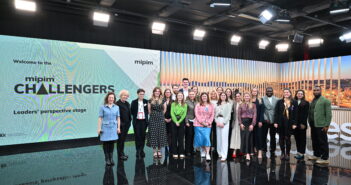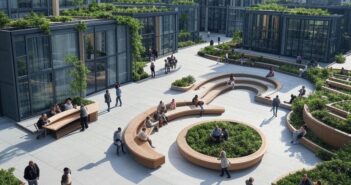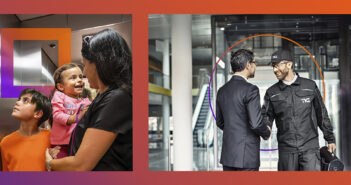Real estate used to be about location, location. It still is. But in today’s world, real estate is as much about what goes on inside a building as about where a building is located.
The power of technology is emerging to create a competitive advantage for owners and occupiers of buildings, including on the sustainability front – and a healthier, happier space for building users.
Yes, we are talking about ‘smart’ buildings, but a smart building means different things to different people. For Kas Mohammed, vice-president of digital energy for Schneider Electric in the UK & Ireland, a smart building is about connectivity.
“Connectivity is needed for optimal levels of efficiency” – Kas Mohammed, Schneider Electric
“Ultimately, connectivity is needed for optimal levels of efficiency. A truly smart building is able to communicate across different systems and services to allow the occupier to make the best possible decisions, whether automatically or by intervening,” says Mohammed.
There is still a way to go before connected buildings becomes the norm, says Mohammed. He estimates that building efficiency can be increased by an average of around 40-50% across the main cities in the world.
“At present, buildings tend to have some sensors, but maybe not in each and every space where people are working, meaning the management team does not have complete visibility of operations and performance,” says Mohammed.
To achieve optimal efficiency, it is about creating one stream of data – the ‘single truth’ – Schneider Electric
To achieve optimal efficiency, it’s about increasing the number of data points and creating one stream of data, which Schneider Electric calls the ‘single truth’.
“This gives the management team confidence in the data coming through, together with the visibility and the transparency, so that they can act quickly to improve the environment,” explains Mohammed.
Global trends: the rise in urbanisation, data and electricity consumption
First, a look at the three main global trends impacting the way buildings need to be designed and resources managed. These are the:
- Massive rise in urbanisation.
- Digitisation and the exponential growth in data and the number of connected IoT products, devices and objects.
- Prediction that buildings will need between 60% and 200% more energy over the next 25 years.
In turn, these trends call for new ways of:
- Using space more efficiently.
- Interpreting and leveraging mega quantities of data.
- Cutting power consumption at a time of climate change.
Creating more engaging & healthier buildings
Technology’s power to create happier and healthier building environments is what will make a building stand out in the future. It’s about creating people-centric buildings.
More and more of us expect the same digitised, personalised and real-time services in the workplace as those provided by digital innovators in the consumer world.
In a truly connected building, collected data can also be connected with a mobile workspace app, to give a sense of control to employees with regards to their work environment.
The 8,000 Société Générale employees at The Dunes, a 126,000 sq m campus in the eastern outskirts of Paris, have access to a mobile app that also, for example, helps them find a parking spot, check the canteen queue, book a meeting room, and personalise their workspace by adjusting lighting and temperature.
Such tools not only empower employees and make them more engaged, but they also increase productivity. In the case of the SocGen building, this saving amounted to over 20 hours a year for each employee, the French bank reported. In addition, 85% of employees said they were “very satisfied” with their office environment.
Your facilities manager can have a greater impact on your health than your doctor, said Laurent Bataille, executive vice-president, digital energy division, Schneider Electric, at last year’s Innovation Summit in Barcelona, quoting research from Harvard University.
Making buildings hyper efficient & sustainable
At the core of a connected building is a single data platform with a network of sensors. The new, award-winning Amsterdam office of real estate services & investment firm CBRE, The Core, for example, has a network of 700 sensors for an office space of 4,700 sq m.
These sensors can identify any underuse or surplus space. Such monitoring can save 15-20% of space occupancy costs when combined with working areas that maximise co-creation and collaboration, such as at The Core, where space is divided into the Workshop, the Client Lab, the Library and the Café.
In the UK, Schneider Electric has helped the University of Nottingham reduce energy consumption by 5%, maintenance costs by 25%, and ‘workspace safety and comfort costs’ (through more efficient safety checks and reduced costs associated with comfort, such as heating and ventilation) by 25%, with the new system paying for itself over a seven to 10-year time period.
Greater efficiency also translates as a reduction in carbon footprint, an important factor for the University of Nottingham. On average, heating, ventilation and air-conditioning systems waste between 25% and 45% of energy, estimates Schneider Electric.
Connected buildings are generating their own energy, as part of the world’s move away from oil and gas
Not only do connected buildings help cut energy consumption, but the buildings themselves are generating their own energy, as part of the world’s move away from oil and gas.
Schneider Electric’s 35,000 sq m head office in Reuil-Malmaison, west of Paris, for example, has reduced net energy consumption by around 30%, of which a third was from installing micro grids on the building roofs to produce solar and geothermal energy.
In Finland, Lidl has cut energy costs at its new distribution centre by up to 70%. It now runs on 100% renewable energy, including energy generated by a combined heating and cooling system, monitored and controlled by the EcoStruxure grid and open software platform developed by Schneider Electric.
The benefits of a single ‘data’ platform
The platform solution provided by Schneider Electric is EcoStruxure, which gathers the data through the sensor network into data highways. The data is then contextualised and leveraged using artificial intelligence.
“As a facilities manager, I can see exactly what is going on with all my systems, which allows me to make informed decisions” – Kas Mohammed, Schneider Electric
The platform is open, allowing for both Schneider and third-party devices to be easily integrated and then connected at scale. The connection of different data streams creates what Schneider Electric calls a ‘single pane of glass’.
“As a facilities manager I can see exactly what is going on with all my systems, which allows me to make informed decisions,” says Mohammed.
Taking this one step further, the real estate industry is currently in the early-adoption phase of the creation of ‘digital twins’, where management teams are able to run different, hypothetical scenarios to foresee outcomes.
The sector is also in the early stages of the integration of health and wellbeing data from individual users into the building’s ‘single pane of glass’. Although such moves can raise privacy issues, says Mohammed, they also open the door for further integration between the building and its users.
As the physical world merges with the online world, the bricks-and-mortar world is starting to see the emergence of ‘living’ buildings. This may in the future give a whole new meaning to the phrase, ‘if these walls could talk’!
Top image: 4X-image / Getty Images



